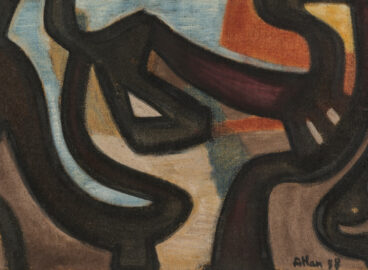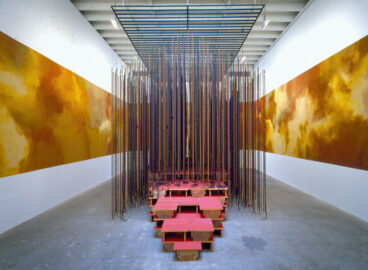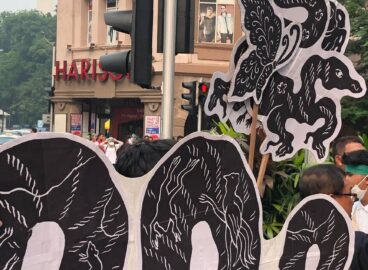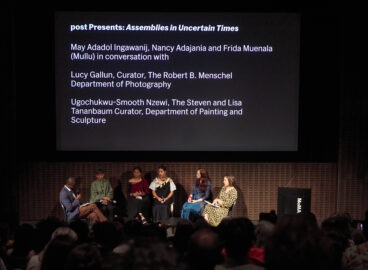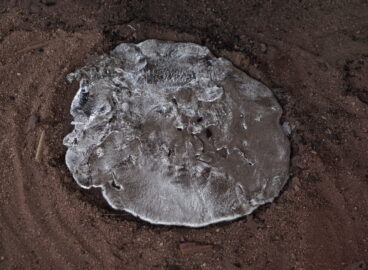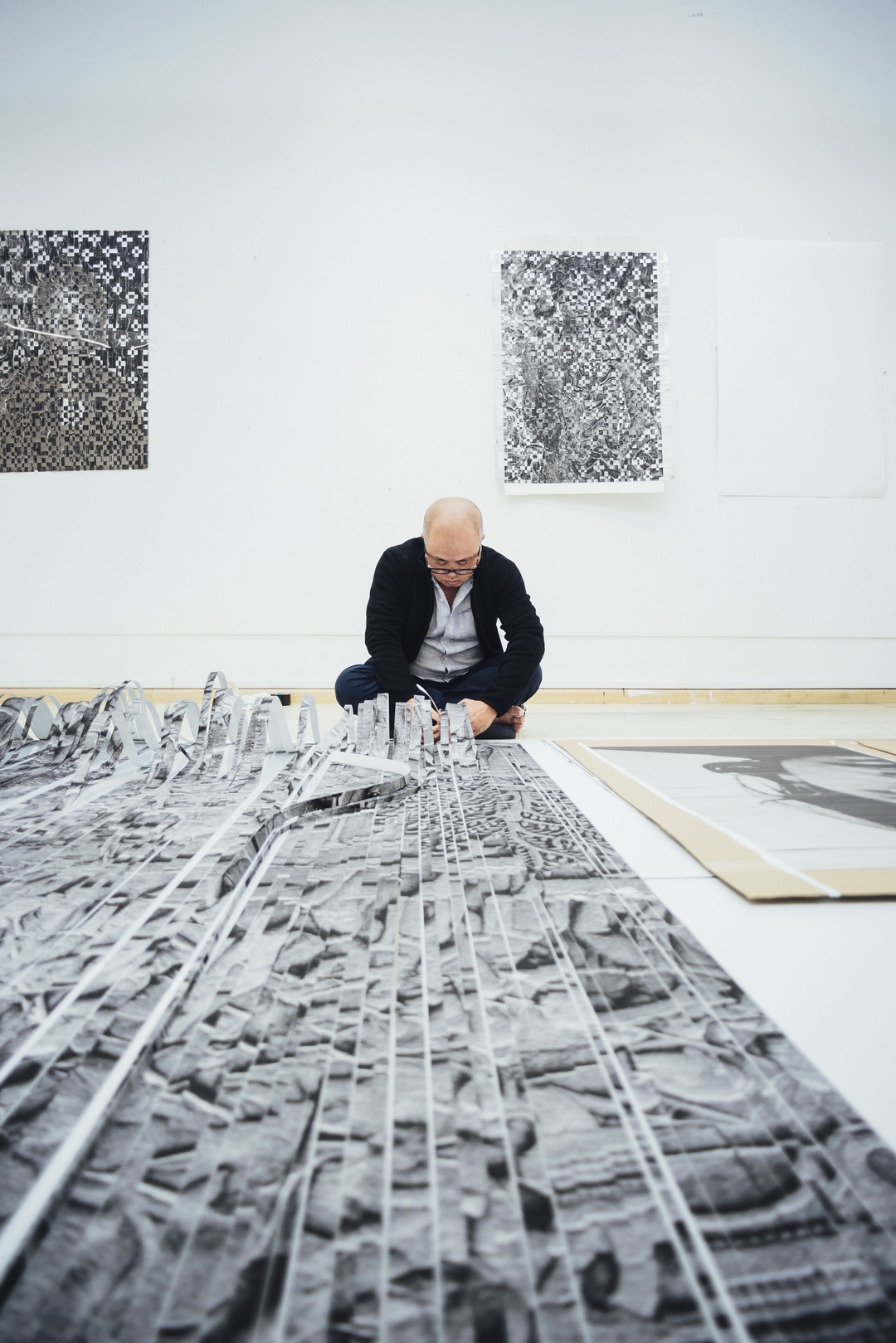
In a series of email conversations with art historian Moira Roth, Dinh Q. Lê (1968–2024) recalled a form of ritual he would perform on each of his trips back to Vietnam. As an act of healing to help his home country recover from the wounds of war, Lê would carry with him some amount of American soil that he would then mix into the water of the Mekong River. In his own words, this action of soil transfusion was a way to “help the wandering souls of all American MIAs lost in the jungle of Vietnam to have some sense of home.”1Moira Roth, “Obdurate History: Dinh Q. Lê, the Vietnam War, Photography, and Memory,” Art Journal 60, no. 2 (2001): 43. Conjuring both the artist’s trajectory from Southeast Asia to the United States and back again and a process of anamnesis across historical and political events, this anecdote is suggestive of the matrix guiding much of Lê’s work, in which histories of war and violence and the individual lives they often overshadow constitute threads—narrative as well as material—that are open to recombination.
Indeed, the act of bringing an element (soil) from a distant place and mixing it with a local element (water), ultimately—all things considered—results in the transformation of both, a process that can be seen as a translation of the method Lê used to create the series for which he is best known, namely his “photo-weavings.”2See Dinh Q. Lê, “Dinh Q. Lê. Works and Primary Documents,” in Midori Yamamura and Yu-Chieh Li, eds., Visual Representations of the Cold War and Postcolonial Struggles: Art in East and Southeast Asia (New York: Routledge, 2021), 147. Untitled (Soldiers at Rest) (2003) belongs to this body of work, which resulted from Lê’s long-term archaeological investigation of the visual culture of the American War (known as the Vietnam War in the United States), via a traditional Vietnamese weaving technique. Lê learned the latter from his aunt who, when he was a child in Vietnam, wove grass mats, and he later adapted this traditional craft for his own purposes. As Christopher Miles, an artist, curator, and friend of Lê has noted, the function of weaving was, for Lê, both “an effective method and a powerful metaphor” in addressing the layering of personal, historical, and cultural registers operating in his practice.3Christopher Miles, “Dinh Q. Lê: Anxious Tapestries,” in Christopher Miles and Moira Roth, eds., Dinh Q. Lê: From Vietnam to Hollywood (Seattle: Marquand Books, 2003), 7. In an attempt both to interrogate the construction of representations of Vietnam and the way his own subjectivity related to them and to explore how “to take back control of those images,” Lê cut chromogenic prints of archival and found imagery into strips that he interlaces into composite pictures.4Andrew Maerkle, “Dinh Q Lê. Simply Unforgettable,” ART iT, September 14, 2015, https://www.art-it.asia/en/u/admin_ed_itv_e/tqg3jxuuvnprlbyz0ofh/.
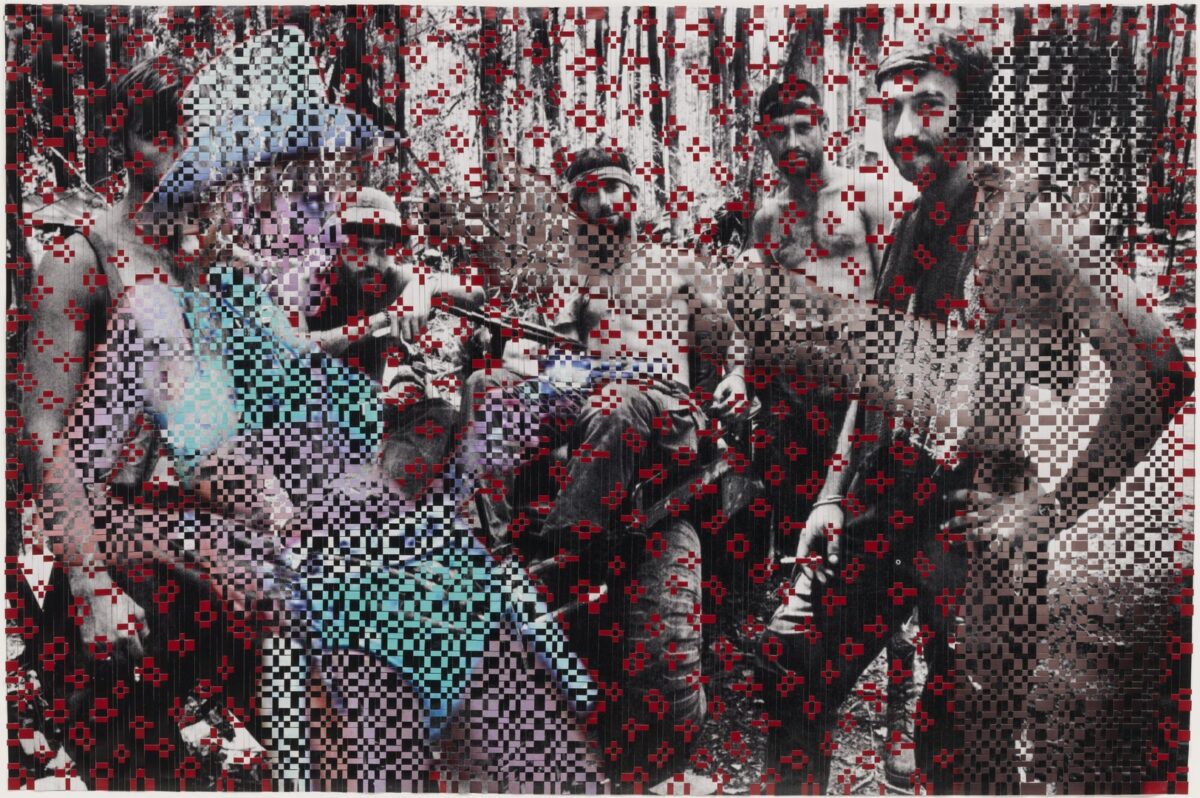
Untitled (Soldiers at Rest) shows a group of five men who, as the title suggests, are taking a break from their military duties. This moment of pause from the temporality of war is signaled through their bare chests and laid-back demeanors. They smile at the camera; one man in the foreground can be seen holding a cigarette. Elements of warfare are identifiable, mainly in the form of a vehicle that, at the center of the image, one of the soldiers is seated upon. This scene is interlaced with two other characters whose presence produces an impression of spectrality and wards off any attempt to capture the image as a whole—that is, to find an all-encompassing meaning within it. The most easily discernible of them is Cynthia Wood in her iconic role as a Playboy Playmate in Apocalypse Now (1979). Wearing a pale sky-blue cowgirl outfit and white hat, she appears in a number of Lê’s other woven photographs, including in Paramount (2003), Untitled 9 (2004), and From Vietnam to Hollywood (paratroopers) (2005), as part of his endeavor to examine the connection between sexualized imagery and imagery of war and political violence. Wood’s inclusion in Untitled (Soldiers at Rest) seems to aim to problematize certain binaries within the image. Often, black-and-white images are archival or photojournalistic and so Wood is rendered in bright colors—in contrast to the soldiers. Furthermore, the men’s faces are identifiable, while hers is partially blurred through the effects of crosshatching—the mark of Lê’s “own style of weaving.” As the artist has declared, “There are parts where I skip weaving to make a certain part of the image clearer or to hide an area.”5Moira Roth, “Obdurate History: Dinh Q. Lê, the Vietnam War, Photography, and Memory,” in Miles and Roth, Ding Q. Lê, 50. In Apocalypse Now, the arrival of Playmates in the Vietnamese jungle to perform for the soldiers results in the latter’s display of violent virility—led by their drive toward a fantasized full satisfaction that, in fact, exposes the military’s impotence. However, in Lê’s image, this scene is not reduced to the mere spectacle of the female body offered to the male gaze—or even to its critique. The quasi-kinetic dimension of Lê’s photo-weavings, when encountered in real space, invites the viewer to a wander of body and gaze, and to a back-and-forth examination of “hidden” elements and of the work in total. And so, on closer inspection, Untitled (Soldiers at Rest) reveals the silhouette of a man who, emerging from the right-hand edge of the picture, stands face-to-face with Wood, his arm stretched toward her and blending in the picture as he reaches out to her. Within this triangular scenario, it is unclear (at least to the author of the present speculation) which gazing subject is the object of Wood’s lascivious pose. As already mentioned, the soldiers seem to stare at the camera—or the viewer—and the way Lê has crosshatched Wood’s right eye directs her gaze in the same direction. As for the character on the right, Lê has woven a strip of the soldiers in the other image into the area of his eye socket.
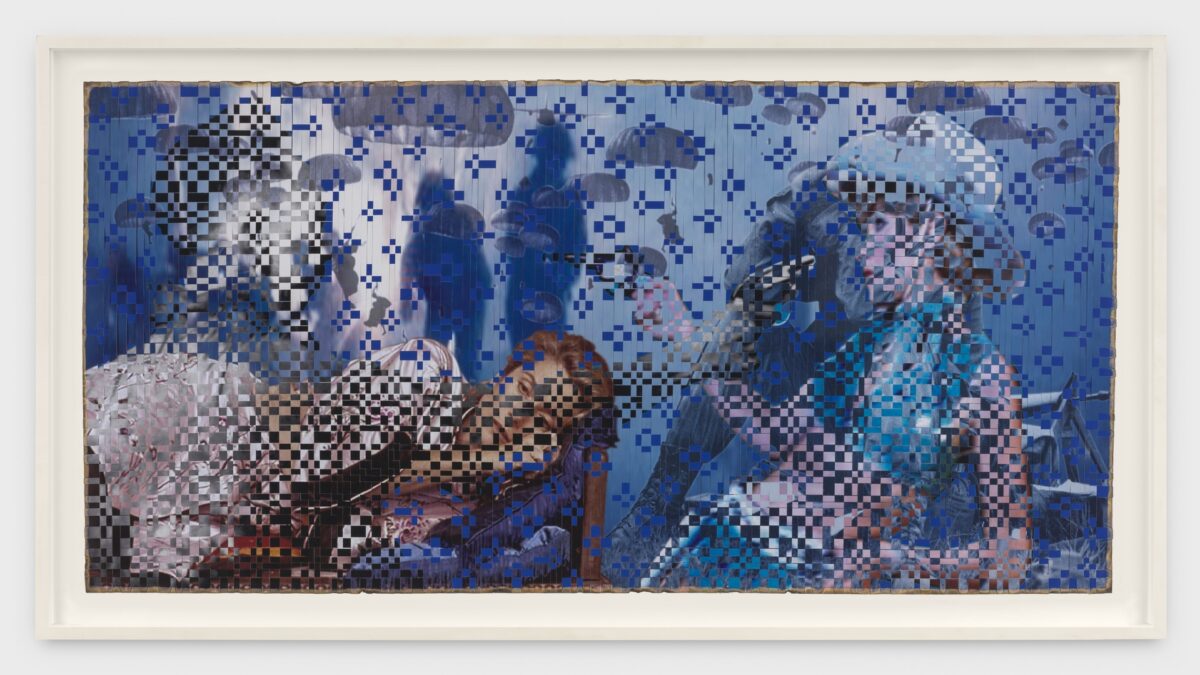
Having experienced war and refugeehood, Lê’s questioning of what forms the memories of Vietnam led him to undo their established representations and to “start to insert other narratives,”6Dinh Q. Lê. “‘Drifting in This Dark Space’: A Conversation with Artist Dinh Q. Lê,” interview by Sean Metzger, Theatre Journal 75, no. 3 (September 2023): 28. a process that, as major commentators of Lê’s work have noted, “can be seen as acts of repair or as a kind of memorial.”7Nora A. Taylor, “Re-Authoring Images of the Vietnam War: Dinh Q Lê’s ‘Light and Belief’ Installation at dOCUMENTA (13) and the Role of the Artist as Historian,” South East Asia Research 25, no. 1 (March 2017): 54. Here, questions arise: do Lê’s gestures of interlacing, interweaving, or suturing constitute a form of critique, and what do these other narratives entail? In this regard, Lê stated in a 2023 interview: “Everything’s kind of merging, so I was trying to break the whole thing apart into pieces or to deconstruct it, to start to talk about how everything is merging between facts, between fiction, between personal memories into this landscape of surreal memories, neither facts nor fiction.”8Lê, “Drifting in This Dark Space,” 28. As this statement on merging levels of realities and the constructed scenario of Untitled (Soldiers at Rest) suggests, the insertion of other narratives produces indeterminacy and undecidability relative to the legibility and visibility of the images he produces. My contention is that this phenomenon relates as much to the material condition of weaving as to its conceptual and psychic dimensions. Although rarely discussed by his commentators, the visual likeness between Lê’s woven photos and the texture of early electronic videos is striking, and it is something the artist himself commented on: “I always think of the weaving in terms of pixels, because weaving is the first binary structure. Maybe not exactly from the start, but certainly over the years I have been working on the project, and particularly after the first body of work in the late 1980s, I was aware of that relationship.”9Maerkle, “Dinh Q Lê.” Thus, it can be inferred that the site that interlaces the personal with the political is precisely the minimal unit of a woven image—the stitch, the point of suture, or the pixel. A suture closes a wound but in so doing, makes it visible; and to borrow from philosopher Maurizio Lazzarato’s writings on the videographic image, similarly, Lê’s “weaving, dissolving, and re-weaving flows . . . is radical constructivism in politics as well as in the . . . image.”10Maurizio Lazzarato, quoted in Helen Westgeest, Video Art Theory. A Comparative Approach (Chichester, West Sussex, UK: John Wiley, 2016), 31.
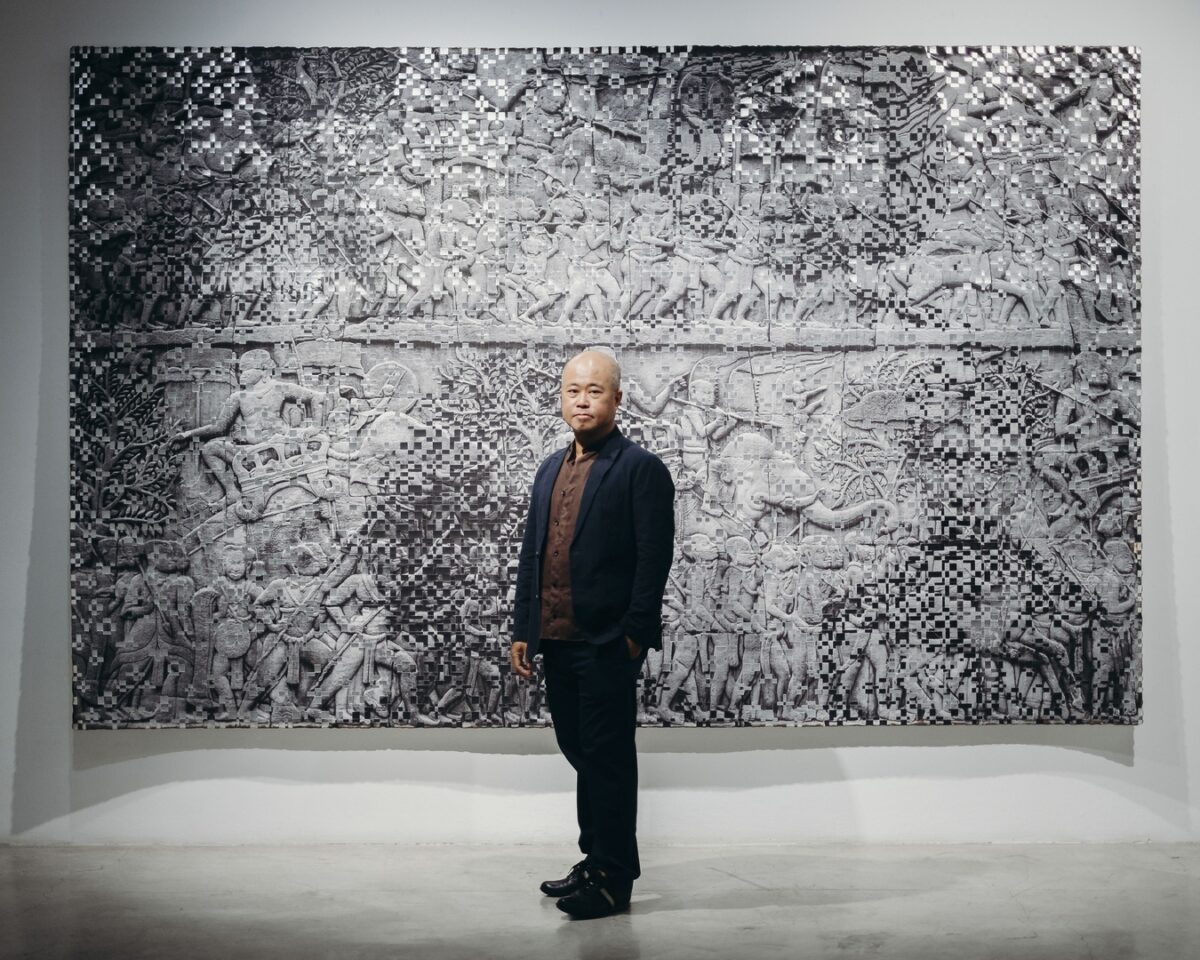
In memory of Dinh Q. Lê and to our missed encounters. Thank you to post editors Beya Othmani, Carlos Quijon, Jr., and Elena Pérez-Ardá López for making this encounter of another kind possible.
Untitled (Soldiers at Rest) (2003) is currently on view as part of the presentation titled “War Remembers Me” in Gallery 214.
- 1Moira Roth, “Obdurate History: Dinh Q. Lê, the Vietnam War, Photography, and Memory,” Art Journal 60, no. 2 (2001): 43.
- 2See Dinh Q. Lê, “Dinh Q. Lê. Works and Primary Documents,” in Midori Yamamura and Yu-Chieh Li, eds., Visual Representations of the Cold War and Postcolonial Struggles: Art in East and Southeast Asia (New York: Routledge, 2021), 147.
- 3Christopher Miles, “Dinh Q. Lê: Anxious Tapestries,” in Christopher Miles and Moira Roth, eds., Dinh Q. Lê: From Vietnam to Hollywood (Seattle: Marquand Books, 2003), 7.
- 4Andrew Maerkle, “Dinh Q Lê. Simply Unforgettable,” ART iT, September 14, 2015, https://www.art-it.asia/en/u/admin_ed_itv_e/tqg3jxuuvnprlbyz0ofh/.
- 5Moira Roth, “Obdurate History: Dinh Q. Lê, the Vietnam War, Photography, and Memory,” in Miles and Roth, Ding Q. Lê, 50.
- 6Dinh Q. Lê. “‘Drifting in This Dark Space’: A Conversation with Artist Dinh Q. Lê,” interview by Sean Metzger, Theatre Journal 75, no. 3 (September 2023): 28.
- 7Nora A. Taylor, “Re-Authoring Images of the Vietnam War: Dinh Q Lê’s ‘Light and Belief’ Installation at dOCUMENTA (13) and the Role of the Artist as Historian,” South East Asia Research 25, no. 1 (March 2017): 54.
- 8Lê, “Drifting in This Dark Space,” 28.
- 9Maerkle, “Dinh Q Lê.”
- 10Maurizio Lazzarato, quoted in Helen Westgeest, Video Art Theory. A Comparative Approach (Chichester, West Sussex, UK: John Wiley, 2016), 31.
